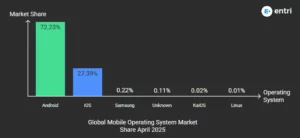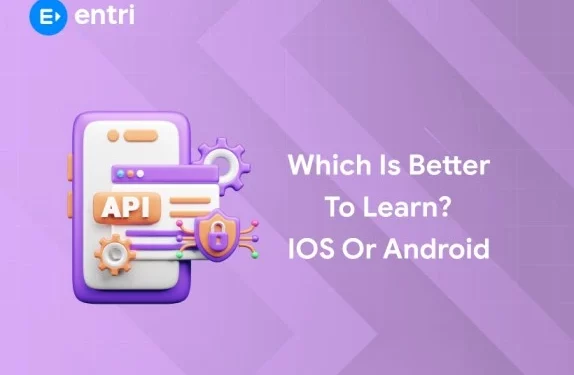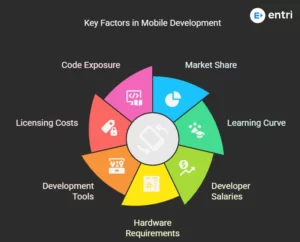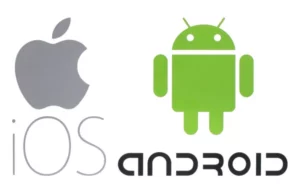Table of Contents
If you’re a mobile application developer or want to become one, you may be wondering which platform is the most beneficial for learning the development process. Both Apple iOS and Android offer great opportunities for developers. This article will provide an overview of the benefits of working on each mobile platform and help you choose which to learn first.
Check out this video by Entri in Malayalam!
Introduction
Choosing between iOS and Android is tough while buying a phone. The toughness increases 3 times when an app developer chooses between them for learning. There is no denying the fact that the iOS and Android are the giants in the mobile operating scene. However, what is the one filter that you should use as an app developer to distinguish between them? Let us find out through this close analysis.
Thinking about developing an app? Create one with Entri’s Flutter training course!
Software development appears to have a bright future, with a projected 22% growth by 2030. Within software development, the mobile development sector is among the fastest-growing software industry segments and is full of work-from-home (WFH), contract, and freelance opportunities. It is also an ever-changing industry, with frequent advancements and updates that mobile developers must effectively navigate, including choosing which development environment they want to work with. Below are a few things to consider when choosing which mobile platform to learn first.
1. Market share
The two most popular mobile operating systems worldwide are Android and Apple iOS. Android and iOS users comprise 99% of the mobile OS market share worldwide. While Android users lead in global market share, Apple iOS has broader adoption in the U.S. and Australia. There are slightly more Apple users in North America as a whole.
Android has a greater market share in Europe, Asia, and Africa.

2. Learning curve
Learning a new development language takes time, and mobile development is no exception. How long it takes to start actively developing iOS or Android apps will depend on your understanding of fundamental development principles.
Consider several important factors when determining the learning curve differences between iOS and Android.
- Apple iOS developers use Swift, Apple’s standard programming language, which typically requires less code and is considered easier to use.
- Android platform developers use Java and Kotlin, which are typically more time-consuming and cumbersome.
- Apple’s App Store has strict requirements that make it difficult to get an app approved in their marketplace.
- Apple’s ecosystem is more controlled as it’s limited to iOS devices (iPhones, iPads, etc.) to develop, maintain, and manage an app post-launch.
- Developers must account for thousands of Android devices running with multiple versions of their OS, including hundreds of different screen sizes. This fragmentation makes it more challenging to develop, test, and maintain post-launch for such a large number of mobile devices.
- Apple iOS applications generally require less development time and have a lower development cost than Android applications.
If you are new to coding, there’s a benefit to learning the Java programming language that goes beyond mobile development. Java is a versatile language that is also used for web development, enterprise applications, and several other use cases. If your goal is to build your development language library, knowing Java will likely offer additional opportunities down the road.
3. Mobile developer salaries
Mobile app developers make an average annual salary of $121,000 a year in the U.S., while in some major cities developers can make as much as $141,000. There’s little difference between iOS versus Android programmers’ salaries. Naturally, there will be salary differences based on experience, industry, and location.
4. Hardware requirements
To begin your mobile application development adventure, you will need to have a powerful enough computer to handle the work. Android Studio and Xcode are the two primary coding tools for mobile software development. Android Studio gets the nod for its cross-platform compatibility, as it is available for Mac and Linux as well as Windows. Xcode is exclusively for Mac unless you’re up for a complicated workaround using Virtual Machine on a Windows PC.
Android Studio is compatible with most operating systems, including Windows, Linux, and macOS.
Windows requirements
- 64-bit Microsoft® Windows® 8/10
- x86_64 CPU architecture; 2nd generation Intel Core or newer, or AMD CPU with support for a Windows Hypervisor
- 8 GB RAM or more
- 8 GB of available disk space minimum (IDE + Android SDK + Android Emulator)
- 1280 x 800 minimum screen resolution
Linux requirements
- Any 64-bit Linux distribution that supports Gnome, KDE, or Unity DE; GNU C Library (glibc) 2.31 or later.
- x86_64 CPU architecture; 2nd generation Intel Core or newer, or AMD processor with support for AMD Virtualization (AMD-V) and SSSE3
- 8 GB RAM or more
- 8 GB of available disk space minimum (IDE + Android SDK + Android Emulator)
- 1280 x 800 minimum screen resolution
Mac requirements
- macOS® 10.14 (Mojave) or higher
- ARM-based chips, or 2nd-generation Intel Core or newer with support for Hypervisor.Framework
- 8 GB RAM or more
- 8 GB of available disk space minimum (IDE + Android SDK + Android Emulator)
- 1280 x 800 minimum screen resolution
Note: Xcode is only compatible with Mac computers and is the go-to software for the iOS development process.
5. Development tools
A number of mobile development tools are available to use when creating applications for Android and iOS. A user experience with an integrated development environment (IDE) is another factor to consider when deciding which tool to use when starting your coding adventure.
The primary development tool for iOS is Xcode, which has several benefits listed below.
iOS development environment (Xcode IDE)
- Mature and intuitive tool with robust support
- Supports the development of all Apple devices, including iPhone, iPad, iWatch, and macOSX
- Includes Code Completion for faster development time
- Additional functionality with managing directories’ hierarchy, profiling, debugging and assets management
Android offers a broader range of tools, so we’ve listed a few below.
Android development environments
- Android Studio. Android Studio allows developers to build automation and customizable build configurations. Configure projects for local and hosted libraries and define build variants with different code and resources, among other tools.
- Eclipse. Developers can use this Java-based tool to develop and test code from other programming languages.
- Visual Studio. Visual Studio is an integrated development environment (IDE) for developing cross-platform applications. It offers writing and editing of source code, debugging, and building executable files.
- Thunkable. Thunkable is a no-code platform for building native mobile applications.
Somewhat subjectively, Apple’s Xcode IDE is a great tool and provides a better overall user experience for developers than Android. However, Android does offer more development tool choices.
Level up in app development with Entri’s Flutter course. Click to know more!
6. Licensing and membership cost
Another factor in your platform considerations is the cost of licensing and membership programs.
While the cost is minimal, developers must subscribe to the Apple Development Program if they want to “distribute apps, access beta software, and integrate with capabilities such as Siri, Apple Pay, and iCloud.” The Apple Development Program costs $99 per year.
Android does not require any subscription services, but there is a $25 one-time registration fee via the Google Play Console.
While the costs are not particularly high for either, it’s worth noting that it’s much harder to get an app approved for the App Store than it is in Google Play. In this category, Android wins on both counts.
7. Code exposure
If you would like your mobile development experience to be a attack into a broader programming career, iOS and Android offer different inroads.
Apple iOS apps were initially programmed with Objective-C, which was a fairly complex programming language. Apple introduced a new, simplified language called Swift in 2014. Swift enables programmers to quickly add many common features with minimal code. Swift is a new streamlined code that saves time and makes the development process easier for new programmers.
Android apps were initially created with Java, which has recently been paired with another language called Kotlin.
Java on its own is used in web development, enterprise applications, and a lot of other use cases. Because of these additional uses, a novice programmer might get more long-term benefits from learning Java.
Both iOS and Android have advantages worth considering. If you plan to focus your efforts on mobile applications alone, Apple iOS will get you in the game sooner. If you are looking at using app development as a springboard for other kinds of programming, it may be worth the extra studying time to start with Android.
The two most popular smartphone operating systems are Apple’s iOS and Google’s Android. When making mobile apps, you must first choose whether to develop for iPhones or Android devices.
Apps made for the Apple App Store differ in various ways from apps made for the Google Play Store:
- Developers use different programming languages when developing for iOS versus developing for Android.
- iOS apps and Android apps require different budgets and maintenance tasks.
- Different mobile operating systems are popular depending on the country one wants to target.
- Android is more customizable than iOS, but not necessarily more popular in every country.
Creating cross-platform apps is a challenge. Trying to publish an app for both iOS and Android at the same time leads to technical issues, expensive costs, and many more challenges. So it is important to choose.
Become an Android App Developer with Entri’s Flutter training course! Join Now!
Which is right for you? Android or iOS?
We have covered some of the differences between Android and Apple iOS, but how can you tell which is the best mobile app development platform to start with? That will depend on your individual goals and your level of experience.
If you are a total coding novice, you will likely benefit from the more controlled ecosystem of Apple iOS. The Xcode development user interface for Apple users allows for less customization—but it does offer more standardization that saves you time and development costs.
If you are already doing development or UI design and are familiar with Java, Android should be the easier path for you. Android development takes more time but also gives you a clearer view of the inner workings of mobile development. Where iOS offers shortcuts, Android requires more fundamental effort and understanding.
Best for most beginners: iOS

Because iOS offers a more controlled ecosystem, a more mature and user-friendly development tool, and a platform that leads in revenue generation, we recommend beginning mobile app developers start with iOS.
What’s good about iOS development?
- User-friendly development tools that reduce coding time and effort
- Large market share in the U.S.
- Highest revenue-generating platform to date
- Slightly higher earning potential
However, if you do not have a Mac computer and do not wish to get one, Android app development is recommended and has the additional benefits listed below.
Android for experienced developers
Experienced Java programmers might find the transition to Android app design easier than learning the Swift language.
What’s good about Android development?
- Multiple development tools available
- Easier to get new apps into Google Play than App Store
- Uses Java language, which offers more potential use cases for long-term career benefit
- Cross-platform development tools can be used on Windows PC, Linux, or Mac
Master Android app development with Entri. Enrol now to elevate your career!
Conclusion: Work as a mobile app developer
Ultimately, the choice depends upon the preferences of the mobile app developer. Since, they would be the ones who would actually work on developing the app, they need to weigh the features of both iOS and Android and contemplate which one suits them better. You may even be required to try out both of them to see which one resonates to your goals.
If you feel like you could do more in the mobile app development, check out Entri’s Flutter training course. With expert mentors and practical applications, you are bound to level up in the realm of mobile app development. So, enrol now to make an impact with Entri!
Frequently Asked Questions
Are iOS apps easier to develop than Android apps?
For both new and experienced programmers, iOS is generally easier to develop for. iOS apps generally require less development time and are cheaper to build and maintain than Android apps.
iOS developers use Swift, Apple’s native programming language, whereas Android developers typically use Java and/or Kotlin. When it comes to native mobile app development, Swift is generally more convenient and requires less coding work. Less coding means cutting costs in terms of time and money for developing an app for iOS products like the iPhone or the iPad.
Which device is better to learn: iOS or Android?
If you want to target Apple product users, learn iOS development; if you want to target different consumer bases, then consider learning Android.
You need to know Swift to develop for iOS. Swift is a modern programming language designed specifically for Apple products. The code is relatively straightforward and easy-to-read for beginner programmers. However, Swift is unique to Apple products and generally not commonly used outside of iOS app development.
Android products rely on Java and Kotlin. While Kotlin is largely confined to just Android app development, Java is a popular programming language that has been around since 1995. The Java programming language has many use-cases outside of Android products; if you are a programmer who is interested in mobile app development but want to keep your options open, then learning Android app development would be helpful for you.
What is the main difference between developing iOS and Android?
There are some crucial differences between iOS and Android app development:
- iOS app developers use Swift, whereas Android app developers use Java or Kotlin.
- With Apple devices, there are standardized screen sizes for iPhones and iPads. With Android devices, there is a large variety of screen sizes—meaning you need to work more on interface design and case-by-case programming to ensure compatibility and functionality across devices.
- Android apps take longer to develop because of device fragmentation—the fact that there are so many different Android OS versions on the market. Different devices get important security updates at different times, and this makes maintaining and developing Android apps more challenging.
- iOS and Android apps have different user demographics—age, income, hours spent on apps, locations, and so on. Apple users tend to be younger and more prosperous than Android users.
When developing apps, consider these differences, analyze your target audience, and ask yourself whether you want to minimize the amount you spend on development time and maintenance.
Do iOS or Android apps make more money?
Mobile apps are a great way to generate revenue. Both iOS and Android apps make a lot of money:
- The Android market has a broad global reach and has a lot of earning potential.
- The Apple App Store has an arguably larger market with more profit.
As of 2019, the Apple App Store had earned $155 billion in revenue for its app developers since the store launched in 2008. By comparison, in 2019, Android developers have only earned $80 billion since launch.













